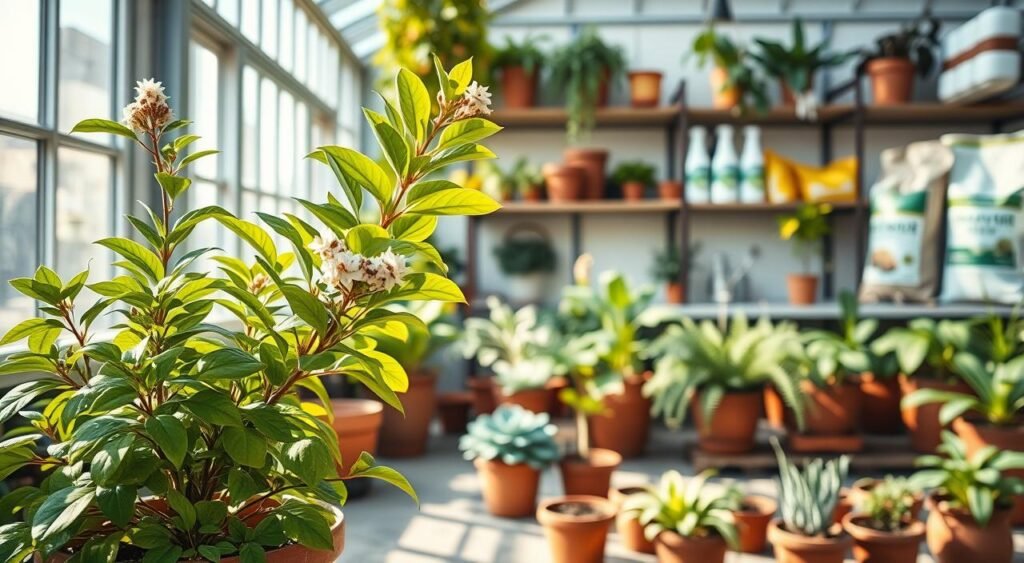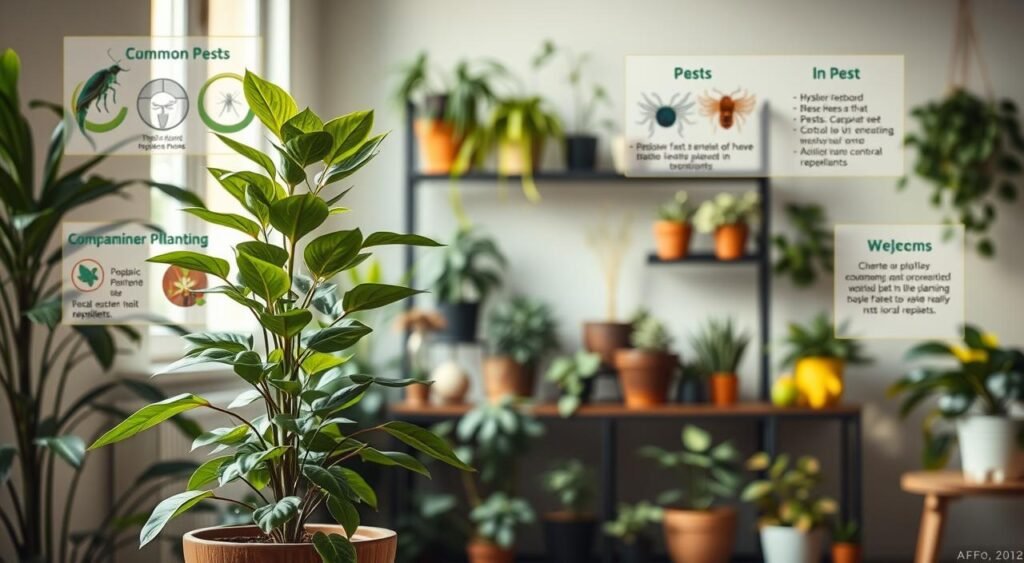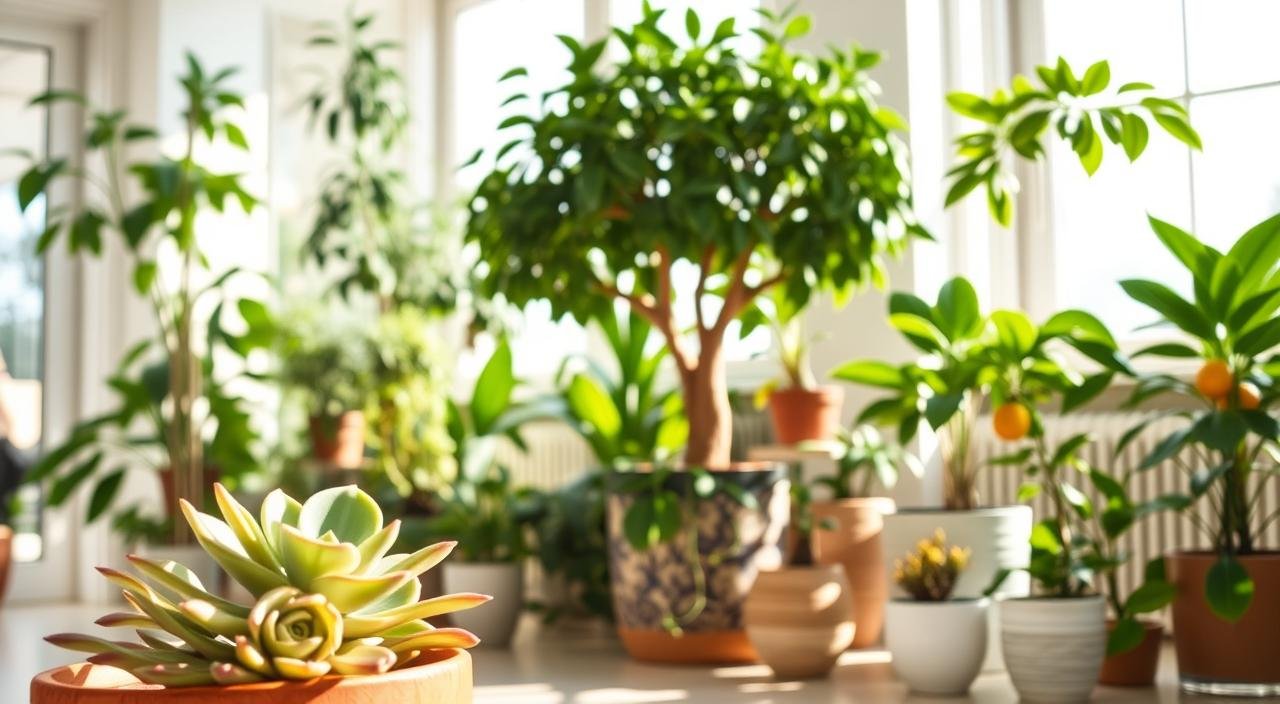Did you know 50% of houseplant owners struggle with winter care due to low light and humidity? Indoor plants respond to outdoor changes like daylight shifts and temperature drops, even inside. Proper seasonal adjustments can help plants thrive year-round, reducing stress for both plants and their owners.
Houseplants like Bamboo Palms need just 10% of direct sunlight, while Orchids require 80% of ideal light from southern windows. Seasonal Affective Disorder affects 5% of U.S. adults, but houseplants can boost mood and clean air. This guide explains how to adapt plant care routines to each season’s challenges, from spring growth spurts to winter dormancy.
Key Takeaways
- 50% of owners face winter care struggles.
- 30% of plant issues come from outdoor pests.
- Low-light plants thrive on just 10% direct sunlight.
- Rotate plants weekly to cut uneven growth by 40%.
- 5% of Americans experience SAD, but plants improve indoor air quality.
Understanding Seasonal Changes for Indoor Plants
Houseplants rely on seasonal light cues to regulate growth, even indoors. Indoor gardening success depends on aligning care with these natural rhythms.
How Seasons Affect Plant Growth
Light wavelengths shift with seasons, triggering growth phases. Winter’s blue light (400-500nm) slows growth, signaling dormancy. Spring’s balanced light spectrum boosts chlorophyll production, sparking new leaves. Summer’s intense red wavelengths increase photosynthesis, raising watering needs. Autumn’s golden light can trigger flowering in species like kalanchoes.
Common Indoor Plants and Their Seasonal Needs
Adjust care based on plant types and seasons. Ferns need reduced watering in winter—every 10–14 days—to avoid root rot. Cacti and snake plants thrive with water every 3–4 weeks during colder months. Spring calls for weekly watering for moisture-loving plants like peace lilies. Overwatering risks fungus gnats; monitor soil dryness before watering.
Seasonal light shifts also influence flowering. Holiday cacti and chrysanthemums bloom in fall when light mimics natural autumn hues. Adjust fertilizing and humidity based on these cycles to keep houseplants healthy year-round.
Spring Care Tips for Indoor Plants

Spring marks the start of active growth for indoor plants, making it crucial to adjust care routines. How to care for indoor plants effectively during this season involves three key steps: watering adjustments, repotting, and leaf maintenance. These plant tips ensure your plants thrive as days lengthen.
Encouraging New Growth
- Increase watering frequency as daylight extends—check soil moisture daily for tropical plants.
- Begin monthly feedingsings with diluted balanced fertilizer once new leaves appear; avoid fertilizing freshly repotted plants for 6 weeks.
- Trim yellow leaves and leggy stems to redirect energy to healthy growth.
Repotting and Refreshing Soil
Repot plants showing roots at soil surfaces or escaping drainage holes—signs seen in 30% of indoor plants annually. Choose a pot 1-2 inches wider than the current container to avoid overpotting. Use fresh potting mix to replenish nutrients.
| Sign | Action |
|---|---|
| Roots visible on soil surface | Repot immediately |
| Water drains instantly | Repot to improve soil retention |
| No visible roots | Wait 6-12 months before repotting |
After repotting, wait 6 weeks before resuming fertilization to avoid burning tender roots. Monitor soil moisture carefully, as overwatering affects 10-15% of indoor plants.
Summer Care Strategies for Indoor Plants
Summer’s bright light and warm temperatures demand careful adjustments for thriving best indoor plants. Monitor soil moisture closely—check the top inch of soil daily. When dry, water thoroughly to avoid dehydration, as plant care routines may shift weekly in summer heat. Overwatering risks persist, so always let pots drain completely after watering sessions.
Adjust sunlight exposure to prevent leaf scorch. Plants like monstera or fiddle leaf figs may need relocation to indirect light spots. Rotate plants every 2-3 weeks to ensure even growth and avoid leaning toward light sources. Use sheer curtains to diffuse intense midday sun for sensitive varieties.
- Water when soil top is dry, but avoid letting plants sit in standing water.
- Wipe leaves weekly with a damp cloth to remove dust and pests.
- Reduce fertilizer to half-strength during extreme heatwaves to prevent root burn.
Raise humidity levels with pebble trays or misters, focusing on tropical plants like calathea that thrive in moist air. Check for pests weekly—squash visible bugs manually or treat with insecticidal soap for outbreaks. Prioritize airflow to deter fungal issues caused by stagnant moisture.
Fall Care Essentials for Indoor Plants

As autumn approaches, indoor plants begin conserving energy for winter dormancy. Adjust care routines to match nature’s slowdown, ensuring your indoor plants stay resilient through the cooler months.
Preparing for Lower Light Conditions
Fall’s shorter days mean low light plants need strategic placement. Move indoor plants closer to sunny windows and rotate them weekly to balance light exposure. Clean windowpanes dust to boost light penetration by up to 30%. For plants like pothos or ZZ, reduce direct sun exposure but keep them near east- or west-facing windows.
Adjusting Watering Habits
Cut watering frequency by half compared to summer. Water indoor plants only when the top 2 inches of soil are dry. Snake plants, for example, may need watering every 6 weeks in fall instead of 3 in summer—a 50% reduction. Suspend fertilizing after September to avoid stressing plants.
| Care Aspect | Summer | Fall |
|---|---|---|
| Watering | Weekly | Every 2–3 weeks |
| Fertilizer | Monthly | Stopped until spring |
| Light | Partial shade | Maximize natural light |
Repotting should wait until spring; fall’s slower growth makes it risky. Monitor nighttime temps—if they drop below 55°F, bring outdoor plants indoors immediately.
Winter Care Best Practices for Indoor Plants
cold air and short days demand careful attention to keep indoor plants healthy. Indoor gardening success hinges on adapting care routines to match dormancy. Start by shielding plants from drafty windows and doors—cold drafts can damage foliage, especially for tropical varieties like ferns and peace lilies. Maintain temperatures above 55°F, as prolonged exposure to colder temps harms most species.
Adjust watering schedules drastically. Most plants need water every 2–3 weeks in winter, a 75% reduction from summer routines. Use a moisture tester to check soil 2 inches deep before watering—dry soil here means it’s time. Avoid leaving saucers under pots to prevent roots sitting in water, which causes rot.
- Move plants 3–4 feet away from heating vents to avoid dry air stress
- Group plants to boost humidity naturally, but ensure airflow prevents mold
- Use pebble trays filled with water to raise humidity without overwatering
Humidity struggles? Run a humidifier 4 days a week in rooms with indoor plant decor collections. Monitor with a hygrometer—most plants thrive at 40–60% humidity. Scrape off white mold from soil surfaces immediately; this signals overwatering. When decorating, choose porous pots to let soil breathe and prevent waterlogging during holiday indoor plant decor displays.
Repotting should wait until spring, as winter dormancy makes recovery slow. Fertilize lightly—only once a month—with a balanced formula diluted to ¼ strength to support slow growth. Inspect leaves weekly for pests like spider mites thriving in dry air. A light dusting with a microfiber cloth improves photosynthesis and wards off pests.
Choosing the Right Indoor Plants for Each Season

Selecting the best indoor plants starts with matching their needs to seasonal changes. Every plant has preferences for light, humidity, and care—knowing these helps them thrive year-round.
- Winter: Snake plants (Sansevieria) handle low light better than other houseplants. Move string of pearls to sunny windows to avoid winter decline.
- Spring: Fiddle leaf figs (Ficus lyrata) grow best with gradual light exposure.
- Summer: Peace lilies (Spathiphyllum) bloom longer in humid, bright spots.
- Fall: Calatheas and bird’s nest ferns adapt to cooler, less intense light.
Year-Round Winners:
- Philodendrons tolerate lower light but grow 30% slower, making them ideal for consistent care.
- Dracaena varieties stay under 4ft tall indoors, fitting most spaces.
- Snake plants need watering only when soil dries 1″ deep, making them low-maintenance.
Light matters most. East-facing windows give 5,000–8,000 ft-c light, perfect for plants like dracaena. South windows hit 10,000 ft-c at noon, ideal for cacti. North-facing areas (200 ft-c) suit ZZ plants and pothos. Pair plant choices with your home’s light conditions for success.
Fertilizing Indoor Plants Throughout the Seasons
Adjusting fertilizer use with the seasons keeps plants healthy without stressing roots. Proper plant care ensures nutrients match growth cycles. Follow these plant tips to avoid overfeeding or nutrient gaps.
How to Choose Seasonal Fertilizers
Match fertilizer strength and type to each season’s needs. Use these guidelines:
- Spring: Start with a diluted (½ strength) balanced NPK (15-15-15 or 20-20-20). Apply monthly until October.
- Summer: Increase to full strength for fast growers like pothos every 3–4 weeks.
- Winter: Pause feeding entirely for most plants. Resume in March.
- Use slow-release or organic options for consistent feeding without overapplication.
Signs Your Plants Need Nutrients
Watch for these cues to adjust your routine:
- Yellow leaves: Possible nitrogen deficiency.
- Brown leaf edges: Over-fertilization risk—cut back feeding.
- Stunted growth: Check phosphorus levels.
- Wilting without dry soil: Root damage from excess fertilizer.
| Season | Frequency | Notes |
|---|---|---|
| Spring | Monthly | ½ strength, balanced NPK (e.g., 15-15-15) |
| Summer | Every 3–4 weeks | Full strength for vigorous plants |
| Fall | Reduce or stop | Cut back as growth slows |
| Winter | None | Suspend feeding except in bright, warm rooms |
Always dilute fertilizers to half-strength to prevent root burn. Adjust schedules based on light and plant type for optimal plant health.
Indoor Plant Pests and Seasonal Vulnerabilities

Protecting indoor plants from pests requires seasonal awareness. Proper how to care for indoor plants includes monitoring for insects that thrive in different climates. Early detection prevents damage to your greenery.
Common Pests to Watch For
Pests adapt to seasons, making timing key to control. Below are top threats and their signs:
| Pest | Peak Season | Signs |
|---|---|---|
| Fungus Gnats | Winter | Small flies near soil, larvae in damp soil |
| Spider Mites | Winter | Yellow speckles, webbing |
| Aphids | Spring | Deformed leaves, sticky residue |
“Quarantining new plants for 6 weeks reduces pest spread”
Preventative Measures by Season
- Winter: Let soil dry between waterings to stop fungus gnats
- Spring: Inspect new growth weekly for aphids
- Summer: Use neem oil for mealybugs on plants moved indoors
Scale insects can form waxy coatings, making treatments challenging. Insecticidal sprays must contact pests directly, requiring multiple applications. Regular checks and how to care for indoor plants with balanced watering reduce risks. Always isolate infested plants immediately to protect others.
Seasonal Tools and Resources for Indoor Plant Care
Successful plant care demands the right tools and resources to adapt to seasonal changes. Year-round essentials include moisture meters to avoid overwatering—critical since soggy soil causes root rot in 90% of cases. A sharp pair of pruning shears and a watering can with a narrow spout for precise hydration top the list. For indoor plant decor, invest in a 6-tier bamboo stand to maximize space while enhancing room aesthetics.
- Moisture meters (Sustee/GrowProbe) to check root-level soil dryness
- Grow lights for winter light supplementation
- Humidity trays and neem oil sprays for pest control
Resources like the PictureThis app delivers instant plant ID and seasonal care alerts. Join local gardening clubs or forums to connect with experts—85% of gardeners report better plant health after community advice. Pair tools like Schultz’s fertilizer (7 drops per watering) with eco-friendly sticky traps for pests. Adjust tools seasonally: swap mister bottles for heaters in winter or fans in summer. Prioritize quality over quantity—invest in one reliable tool each season to build a smart, decorative plant care kit that balances function and style.
Creating a Year-Round Indoor Garden Plan
Successful indoor gardening requires aligning care routines with seasonal shifts. Start by grouping plants by their light and water needs, especially for low light plants that thrive in shaded corners. A calendar marking tasks like spring repotting or winter pest checks ensures proactive care. Hydroponic systems can boost growth by tripling yield speeds, making them ideal for high-demand crops.
Scheduling Care Tasks by Season
Begin with a weekly watering chart to track plant-specific needs. In spring, focus on repotting and fertilizing, while fall schedules prioritize pruning and adjusting light exposure. Square-foot gardening methods maximize space, allowing up to 16 plants per square foot in compact setups. LED grow lights run for 15 hours daily to mimic sunlight, ensuring leafy greens and herbs meet their light requirements.
Keeping Your Plants Thriving All Year Long
Monitor soil moisture weekly using the finger test, avoiding overwatering which affects 25% of plant health issues. Use a 1:1:1 mix of potting soil, coconut coir, and compost for optimal growth. For low light plants, adjust placement near east-facing windows during winter to capture morning light. Vertical shelves 48 inches wide maximize space while hydroponic setups cut growth time by half.
FAQ
How do I know when to water my indoor plants in different seasons?
The watering needs of indoor plants vary with each season. In spring and summer, when plants are actively growing, they generally need more frequent watering. In fall, begin to reduce the frequency as growth slows, and in winter, check the soil moisture regularly since plants enter dormancy and require less water.
What are the best indoor plants for low light conditions?
Some of the best low light indoor plants include pothos, ZZ plants, snake plants, and peace lilies. These varieties thrive in dimmer environments and can adapt well to less natural light, making them ideal choices for challenging indoor spaces.
How can I increase humidity for my indoor plants during winter?
To boost humidity levels in winter, you can group indoor plants together, use a humidifier, or place trays of water near your plants. Another effective method is misting the leaves with water regularly, though be cautious not to oversaturate the soil.
When is the best time to repot my houseplants?
Spring is typically the best time to repot houseplants as they emerge from dormancy and experience renewed growth. Look for signs that your plant is root-bound or the soil is compacted, indicating that it needs more space or fresh soil.
What should I do if my indoor plants show signs of pests?
If you notice pests on your indoor plants, particularly during the spring and summer when infestations can escalate quickly, isolate the affected plant and treat it with insecticidal soap or neem oil. Regular inspections and maintaining optimal growing conditions can help prevent pest issues.
How do I choose the right fertilizer for my indoor plants?
Choose fertilizers based on your plants’ growth patterns. In spring, a balanced, water-soluble fertilizer at half strength can be effective. Heavy feeders, like monstera and pothos, may require a stronger solution during peak growth in summer, while many plants benefit from a break during fall and winter.
What are some effective strategies for adjusting plant care throughout the year?
To adjust care effectively, keep a seasonal calendar outlining monthly tasks such as watering, fertilization, and pest management. Group your plants by similar care needs and document their growth patterns to better anticipate their requirements across seasons.
Source Links
- Tips for Caring for Outdoor Plants that I have Brought Inside for the Winter – https://miraclegro.com/en-us/growing-with-martha-stewart/indoor-winter-plant-care-tips.html?srsltid=AfmBOoo9TjLP6YtbQB902h3iyV-4g1UYUcfNngdup20XXhqGbpgSDWq7
- How Does Seasonal Change Effect Indoor Plants? – https://plantx.com/blogs/vegan-blogs/how-does-seasonal-change-effect-indoor-plants
- The Dance of Light: How Seasonal Changes Affect Your Houseplant Collec – https://urbansproutsstore.com/blogs/sprout-md/the-dance-of-light-how-seasonal-changes-affect-your-houseplant-collection?srsltid=AfmBOoq05BQvFrtFLlkA6B-l-zQcGfyubcPjMh9tU3_kR6ZZKOrNAjKQ
- Seasons of Change: Watering Houseplants Through the Year – Westwood Gardens – https://www.westwoodgardens.com/blog/watering-houseplants-through-the-year
- Getting your houseplants ready for Spring – https://houseplanthouse.com/2021/04/03/getting-your-houseplants-ready-for-spring-2/
- Spring Plant Care Tips and Tricks for Houseplants – The Sill – https://www.thesill.com/blogs/plants-101/seasonal-care-spring?srsltid=AfmBOoq90fmZB5xOF9Br0XkqpDdaZmlejMnDdS0UgGoppmotP3RCqlvw
- The Ultimate Guide To Spring Plant Care – Bloomscape – https://bloomscape.com/plant-care/ultimate-guide-spring-plant-care/?srsltid=AfmBOorBxmjUaEYplKWSNhR7FclqIwTNaypubfLatIbCdMs0-8xWDtCx
- Summer Care for Indoor Plants – https://miraclegro.com/en-us/indoor-gardening/summer-care-for-indoor-plants.html?srsltid=AfmBOorCyWBnPwBq2B53e9HVV0LeJotTfB1hs3wMYgYkzlW2C0uPL63Z
- 8 Top Summer Indoor Plant Care Tips – https://thelittlebotanical.com/summer-plant-care-tips/
- Summer Care Tips To Treat Your Houseplants | Bloomscape – https://bloomscape.com/plant-care/summer-care-tips/?srsltid=AfmBOopD7_iHIUnFcCr-brI-G4FVwJZK4U-SKhG1hwFNxURjYLWARf_p
- Tips for Getting Your Plants Ready for Fall | Bloomscape – https://bloomscape.com/plant-care/getting-your-plants-ready-for-fall/?srsltid=AfmBOopM6pbe7IfwZK6cv_TFxAH1pcHhlrnFzcT4wN_VizMbzpHFvv51
- Fall Plant Care Tips and Tricks for Houseplants – The Sill – https://www.thesill.com/blogs/plants-101/seasonal-care-fall?srsltid=AfmBOoqCVHa3GTpBC63w2CkZqtz1ZRaDc53OcixHc11I57fZv-hUgduE
- How to prep your indoor plants for winter so they don’t die – https://www.lovethatleaf.co.nz/blogs/plant-care-guides/how-to-prep-indoor-plants-for-winter?srsltid=AfmBOoqRERnh4DvSL00G2jJusqXThIEdPqkYSNsHDtzYl2dxJAWSdIb-
- Indoor Plants In Winter: Keeping Your Indoor Plants Alive – https://www.joyusgarden.com/winter-houseplant-care/
- Selecting Indoor Plants | University of Maryland Extension – https://extension.umd.edu/resource/selecting-indoor-plants
- 24 Best Indoor Plants – Find Your Perfect Houseplant – Garden Design – https://www.gardendesign.com/houseplants/best-indoor.html
- Growing Indoor Plants with Success – https://extension.uga.edu/publications/detail.html?number=B1318&title=growing-indoor-plants-with-success
- How to Fertilize Indoor Plants: Ways to Feed Houseplants – https://www.joyusgarden.com/fertilizing-indoor-plants/
- Fertilizer Is the Key to Healthy, Strong Houseplants—Here’s When (and How) to Apply It – https://www.marthastewart.com/when-to-fertilize-houseplants-8599360
- Common Houseplant Insects & Related Pests – https://hgic.clemson.edu/factsheet/common-houseplant-insects-related-pests/
- Houseplant Pests and Control | Cooperative Extension Service – https://www.uaf.edu/ces/publications/database/insects-pests/houseplant-pests.php
- 10 Tips to Ensure Happy, Healthy Houseplants – https://www.bhg.com/gardening/houseplants/care/houseplant-care-guide/
- 11 Must Have Products For Indoor Plant Owners – Clean My Space – https://cleanmyspace.com/10-must-have-products-for-indoor-plant-owners/
- Seasonal Plant Care Made Easy: Essential Strategies for Success – https://www.bumbleplants.com/blogs/plants/seasonal-plant-care-made-easy?srsltid=AfmBOoroOuAz9m3gK3Z9qgTOpCKyqIAHD2QDHzuovrbAsGL3PtzGqK88
- 6 Expert Tips to Create a DIY Indoor Garden – https://cornellfarms.com/blogs/houseplants/6-expert-tips-to-create-a-diy-indoor-garden?srsltid=AfmBOor8DAXGGhQAe2Ul3OfTlISHcfLPrGM1ZsqS33sVS-9uRh89sgvE
- How I Built a Vegetable Garden in My One-Bedroom Apartment – https://food52.com/blog/25298-indoor-gardening-beginner-how-to?srsltid=AfmBOoo8for_nhVl2VDHUOv1-p1y7siuhN1IR0Uc9wO73psK-eEyPclz

